The social media management tool you choose can set the tone for how you grow your presence. You want it to be easy and flexible — without stretching your budget.
Buffer and Later are two names you’ll see often, each offering different ways to help you schedule posts, connect with your audience, and analyze performance.
If you’re weighing your options between Buffer and Later, you’re in the right place. The key differences and similarities to look for between them are:
Jump to a section:
In this guide, we’ll compare the two platforms so you can decide which is the better fit for your brand.
Buffer vs. Later features overview
Here's a look at all the key features and costs for Buffer and Later at a glance.
Plans and pricing
Cost can be one of the biggest factors when choosing a social media management tool, with good reason. You need a tool that has the features you need at a price that makes sense for your brand or business.
Buffer pricing
- Free plan (up to 3 social media accounts/channels) — $0
- Essentials plan — $6 per channel per month (or $5 per channel paid annually)
- Team plan — $12 per channel per month (or $10 per channel paid annually)
See Buffer’s full pricing guide here →
Buffer provides complete flexibility when choosing channels. You can select the exact channels you need and only pay for those channels, making it reasonable for any budget.
Later pricing
- Free plan (up to 8 social media channels, 1 per platform) — $0
- Starter plan — $25 per month for 1 user (or $16.67 per month paid annually) and 1 social set
- Growth plan — $50 per month for 2 users (or $33.33 per month paid annually) and 2 social sets
- Scale plan — $110 per month for 4 users (or $73.33 per month paid annually) and 6 social sets
See Later’s full pricing guide here →
Later’s listed prices are the minimum for each plan, and the final cost could go up depending on the number of users on your team and the social channels you connect.
Later requires paid users to purchase “social sets” that include one of each social channel (Instagram, Facebook, Threads, Pinterest, TikTok, LinkedIn, YouTube Shorts, and Snapchat), which may not suit every user’s needs. Some users have multiple accounts on Instagram, others only want to connect their Facebook Page. For them, Later’s model ends up costing more.
Number of users or seats included
Buffer and Later structure user accounts in different ways. For social media managers especially, it’s worth knowing what each plan includes so you can choose the setup that fits best.
Buffer user accounts: Buffer’s Free and Essentials plans each include one user account, and the Team plan includes unlimited users. This is a major reason why small and medium businesses pick Buffer, since the cost doesn’t increase if you add more users to your team.
Later user accounts: Later’s Starter plan includes one user account. For teams, the Growth plan includes two user accounts, and the Scale plan includes four user accounts. If you need more user accounts, you can purchase additional seats at $5 per user per month ($3.33 per user billed annually) on the team plans.
What this means for you
As you can see, Buffer and Later take different factors into account for the pricing. This can affect how much each tool will cost you at setup and over time as your team, brand, or business grows.
For creators: Later's free plan gives you one social set, meaning you get one account per social media platform. The Starter plan has these same limits and a monthly cost of $16.67 with an annual commitment.
If you need multiple accounts on the same platform — say a LinkedIn profile for your personal brand and a LinkedIn page for your business — you’d need the Growth plan, which is priced at $33.33 per month paid annually.
Buffer has a free plan for up to three social media channels on any platforms, and paid plans start at $5 per month per channel paid annually.
For teams: Later has a fixed number of users on its plans. If you have two social platforms and two users on your marketing team, Later would cost you $33.33 per month paid annually, or $50 paid monthly.
If you need a third channel on the same platform, you’d have to purchase additional social sets. If you need more users, you can take the next tier or purchase more seats.
Buffer’s pricing is based on channels. For two channels and unlimited users, Buffer would cost $20 per month, paid annually, or $24 monthly.
Free trials
If you're curious to see how these features stack up, both Buffer and Later offer free trials of their plans, letting you test everything out for yourself before you pay.
Buffer free trial: 14 days on Essentials and Teams Plans, and you can use up to three social media channels on the free plan.
Later free trial: 14 days on all plans, and you can use up to nine social media channels on the free plan, with a limit of one channel per social media platform.
Social media scheduling and planning
Both Buffer and Later offer plenty of features to easily schedule posts across multiple platforms from a single dashboard.
Let's look at them in more depth.
Available channels
Here's a breakdown of the various social media platforms Buffer and Later support.
Creating and scheduling posts
Both Buffer and Later make it easy to draft and schedule content to multiple social media accounts — across different platforms — at the same time. You can customize the captions or images for each network as you go.
Both tools also let you choose pre-defined time slots to set up a queue for scheduling posts. This way, you don't have to manually set a time for each post to publish on each channel.
Beyond these basic scheduling features, there are some differences in how Buffer and Later work at this stage of your workflow.
Number of scheduled posts: Buffer supports scheduling 10 posts at a time per channel on the free plan and unlimited scheduling on all paid plans. You can have as many posts in your drafts as you'd like.
Later's free plan lets users connect eight social media channels, with only one account available per platform. You can have 12 posts set up at a time for each connected channel. This includes both scheduled posts and drafts.
Later has limits on the number of posts you can schedule even on paid plans. The Starter plan lets you schedule 60 posts per profile per month, and the Growth plan lets you schedule 180. Unlimited scheduling is available on the Scale plan.
Captions and hashtags: Later includes a feature that lets you save captions, which can be handy if you frequently reuse announcements, reminders, or hashtags. You can also get hashtag suggestions, which are generated based on the text of your post.
Buffer has a dedicated hashtag manager, where you can save and organize groups of hashtags to add to your posts quickly. There's also a free Instagram hashtag generator available to everyone — even if you don't have a Buffer account.
Bulk content posting: If you’re planning content at scale, Buffer supports bulk scheduling of up to 100 posts at a time from a CSV file on paid plans. Later doesn’t support bulk scheduling via a CSV, so there’s more manual work involved to schedule larger campaigns.
Number of scheduled posts: Buffer supports scheduling 10 posts at a time per channel on the free plan and unlimited scheduling on all paid plans. You can have as many posts in your drafts as you'd like.
Later's free plan lets users have 12 posts set up at a time for each connected channel. This includes both scheduled posts and drafts.
Later has limits on the number of posts you can schedule even on paid plans. The Starter plan lets you schedule 60 posts per profile per month, and the Growth plan lets you schedule 180. Unlimited scheduling is available on the Scale plan.
First comment scheduling: Buffer supports scheduling a first comment on Instagram, Facebook, and LinkedIn posts for paid plans. Later supports first comment scheduling only on Instagram.
Instagram-specific features: Later offers a visual planner you can use on all platforms, which helps you see your Instagram grid (and Pinterest) before you publish. You can drag images from the media library onto the calendar, then add captions directly from there.
Buffer has an Instagram grid preview feature as well, but there’s no drag and drop directly onto the calendar.
There are also some differences when it comes to posting on Instagram. Later doesn’t support publishing to personal profiles, and Instagram Stories can only be auto-published for business accounts.
If you have a creator profile, you’ll need to use notification publishing for stories. Later’s Android app isn’t available in all countries, so that could pose a challenge for some creators.
Buffer provides more options for Instagram publishing. It supports posting to personal profiles through notifications on the mobile app, and you can post automatically to both creator and business profiles.
Here’s a look at what the post composer and scheduler window looks like in Buffer and Later for scheduling an Instagram post.
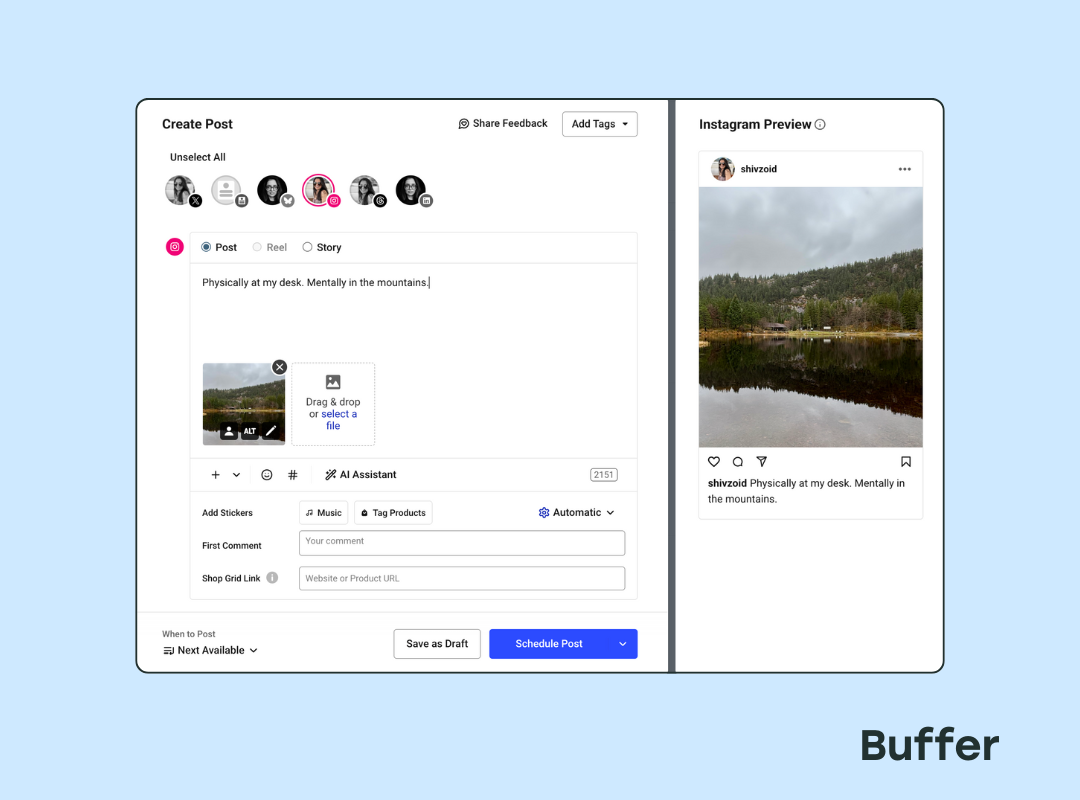
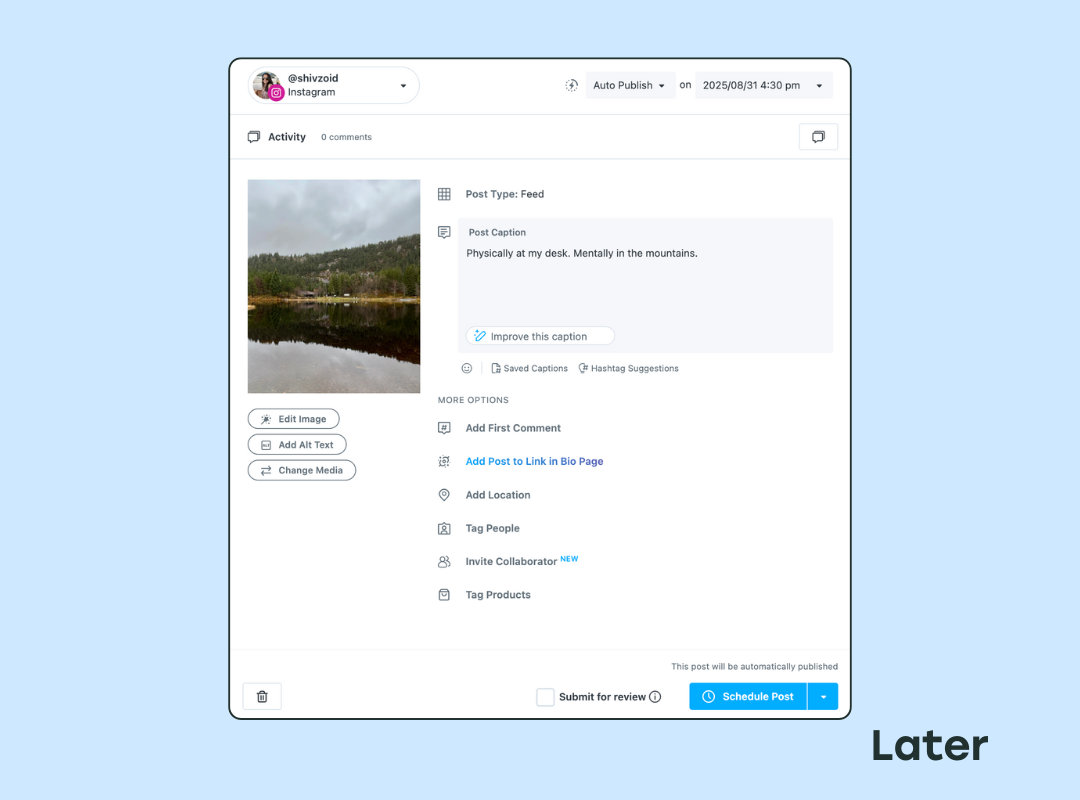
AI features
Both Buffer and Later offer AI tools to make content creation faster and easier, but they handle AI usage differently.
Buffer: Buffer’s AI Assistant is available without limits on all plans, including the free one. You can generate fresh ideas whenever you need them, draft or refine posts or captions, and even repurpose content across multiple social media platforms without worrying about running out of credits.
For creators or teams posting regularly, this removes the risk of hitting a ceiling in the middle of a campaign.
Later: Later offers its AI-powered Ideas tool on paid plans, with a credit system that helps manage how many ideas you can create each month. The number of credits you get depends on your plan, and you spend one credit to generate a caption or three content ideas.
Once those credits are used up, you’ll need to wait until the next month or purchase additional credits.
Capturing ideas and planning content
A great idea for a post can strike at any time, and both Buffer and Later give you a dedicated space to save these ideas so they don't get lost.
Buffer: The Create Space is an ideas hub where you can collect and organize anything you might want to turn into a post later.
You can save notes, text snippets, links, and media, then tag and sort them into a flexible, Kanban-style board that makes it easy to move posts from concept to publish-ready.
The Create Space also includes a template library and access to the AI Assistant to help you get started without staring at a blank screen.
Buffer also has a browser extension for Chrome, Safari, Opera, Firefox, and Edge you can use to easily save ideas that inspire you on the web.
Later: Later’s idea space — available on paid plans — leans heavily on AI to get you going. You start by providing a description of your brand, and the AI will generate content pillars (which you can edit) and a few initial post ideas for you.
From that point, you can continue to use the AI to generate more ideas or add your own thoughts into these pillars.
This gives you a structured starting point, though it’s more narrowly focused on generating prompts than on storing and organizing a wide variety of content inputs and inspiration.
Social media engagement
Buffer and Later both have audience engagement features for managing conversations on different social media networks.
Like the scheduling tools, these engagement tools have some differences as well.
Buffer: As the name suggests, the Community feature (formerly Engage, now in beta) helps you build an engaged social media community across multiple accounts. You can reply to comments quickly from the Community tab right within Buffer, and the AI Assistant even gives you suggestions to kick off the conversation.
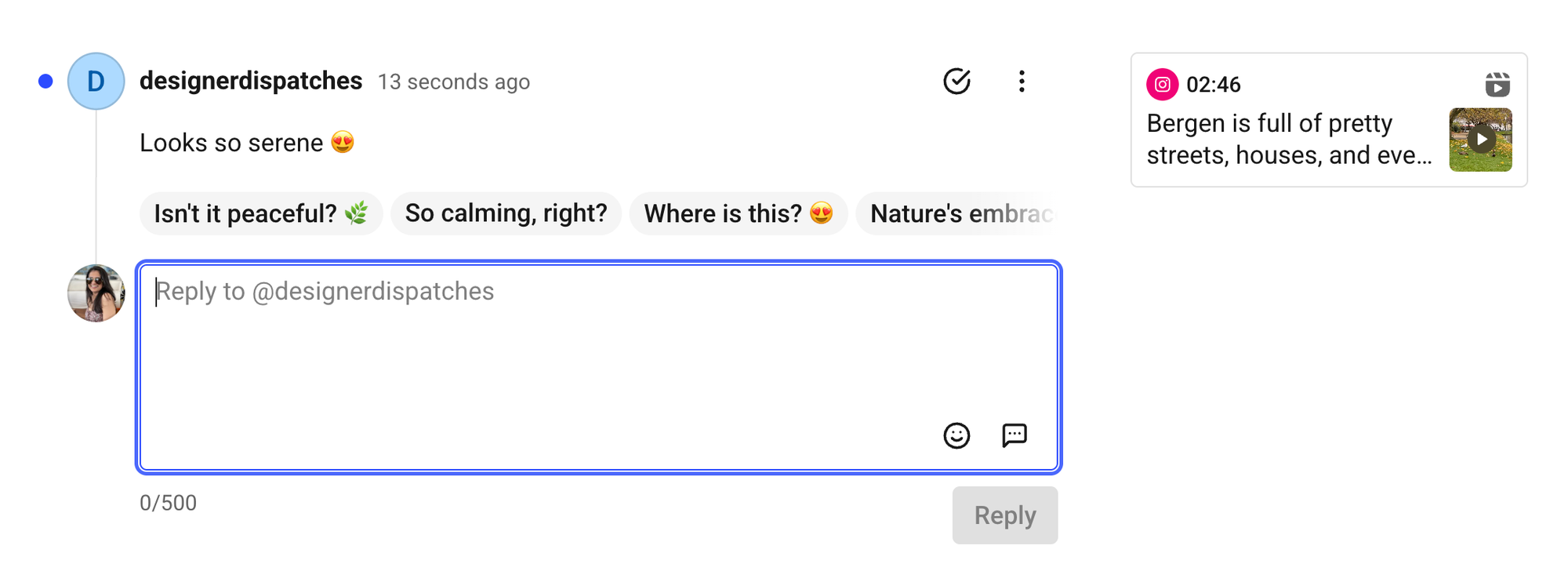
You can also save responses to commonly asked questions. This lets you answer these FAQs quickly without rewriting the same message every time.
To help you see how you're doing, you get a comment score for each channel that tracks how fast and consistently you respond. This visibility helps you see where you’re engaging well and where conversations might be slipping.
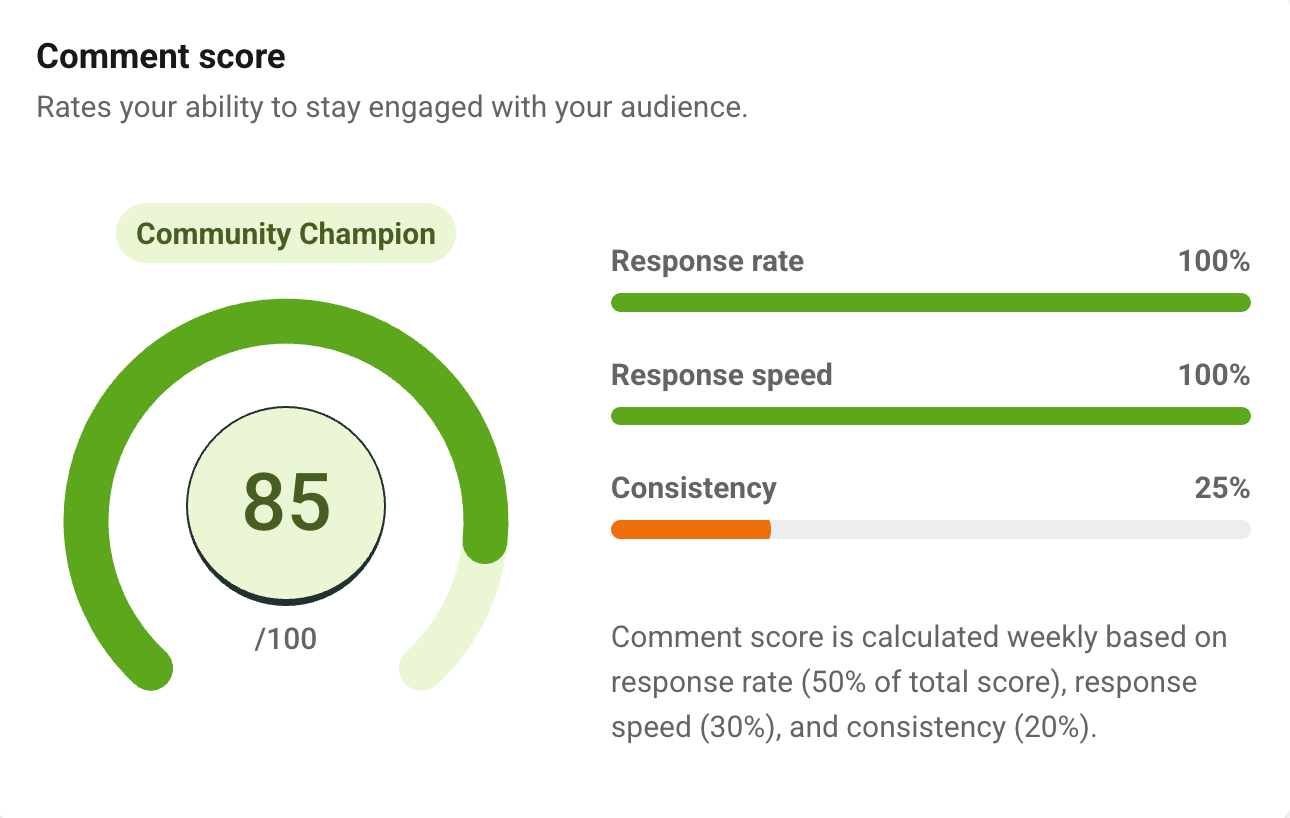
The Community tool also gives you insight into how people are engaging with your content. You can zoom in on comments for a single post or look at replies and mentions across an account. Simply ask the AI to break down the response, highlight patterns, and even suggest new content ideas or ways to keep the conversation active.
Later: The Social Inbox in Later gathers your Instagram and Facebook DMs and comments, along with TikTok comments, in one space. It has a useful feature that lets you hide comments directly from the inbox, which removes them from view on the original platform — handy when you’re dealing with spam or inappropriate replies. The Social Inbox is available on team plans.
Later also offers a social listening tool to help you understand the sentiment around your brand. It finds brand mentions, highlights trending topics, and provides competitive benchmarking to see how you stack up against other brands in your industry.
These features, however, are only available as a paid add-on for users on the Scale plan, and it comes at an additional cost that Later says depends on “each brand’s unique needs and goals.”
Social media analytics and insights
Social media analytics tools give you a clearer view of how your content performs. They can help you understand what's working and where to adjust, making it easier to grow across platforms.
Buffer and Later both provide analytics, though they support different platforms.
Buffer’s analytics features
Buffer keeps things easy to follow and includes clear post analytics for every channel it supports so you can see results at a glance. These basic analytics are available for users on all plans, including free.
Advanced analytics become available on the Essentials plan and above, giving you deeper insights for Facebook Pages, Instagram Business and Creator accounts, X/Twitter, and LinkedIn Pages.
These detailed analytics include a cross-channel overview, which pulls data from all of your connected channels into one dashboard.
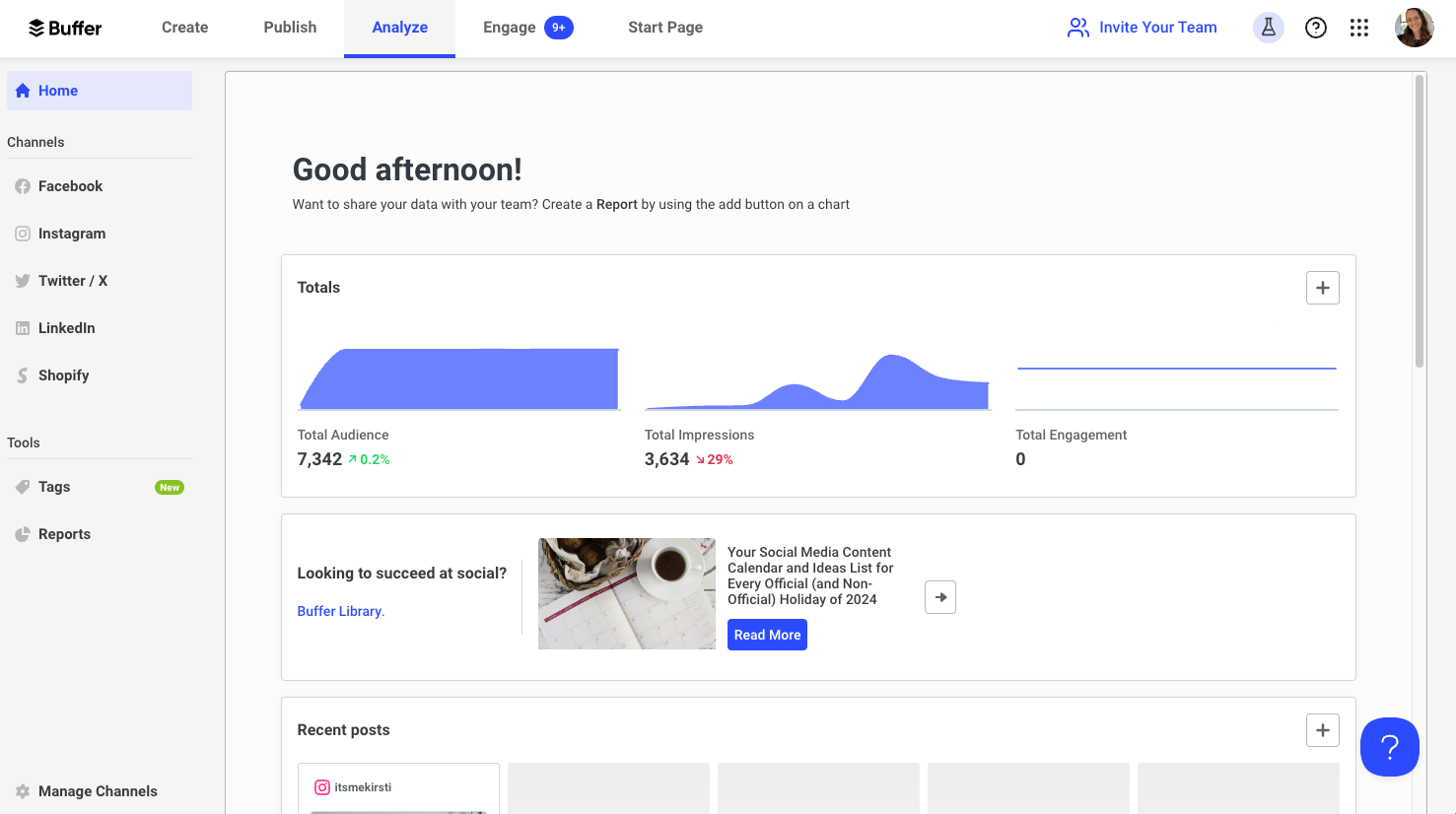
You can dig a little deeper into the analytics for each available channel and see important performance metrics like impressions, reach, engagement, new followers, and likes.
Where Buffer really shines is what it does with this data. You get the raw numbers, and you also get a personalized analysis that shows you how to put these numbers to work.
Under the Answers tab, you'll find recommendations on:
- The best day to post for your audience (for Instagram, you'll also get the best time)
- Your best performing content type or format
- The ideal frequency for you to post
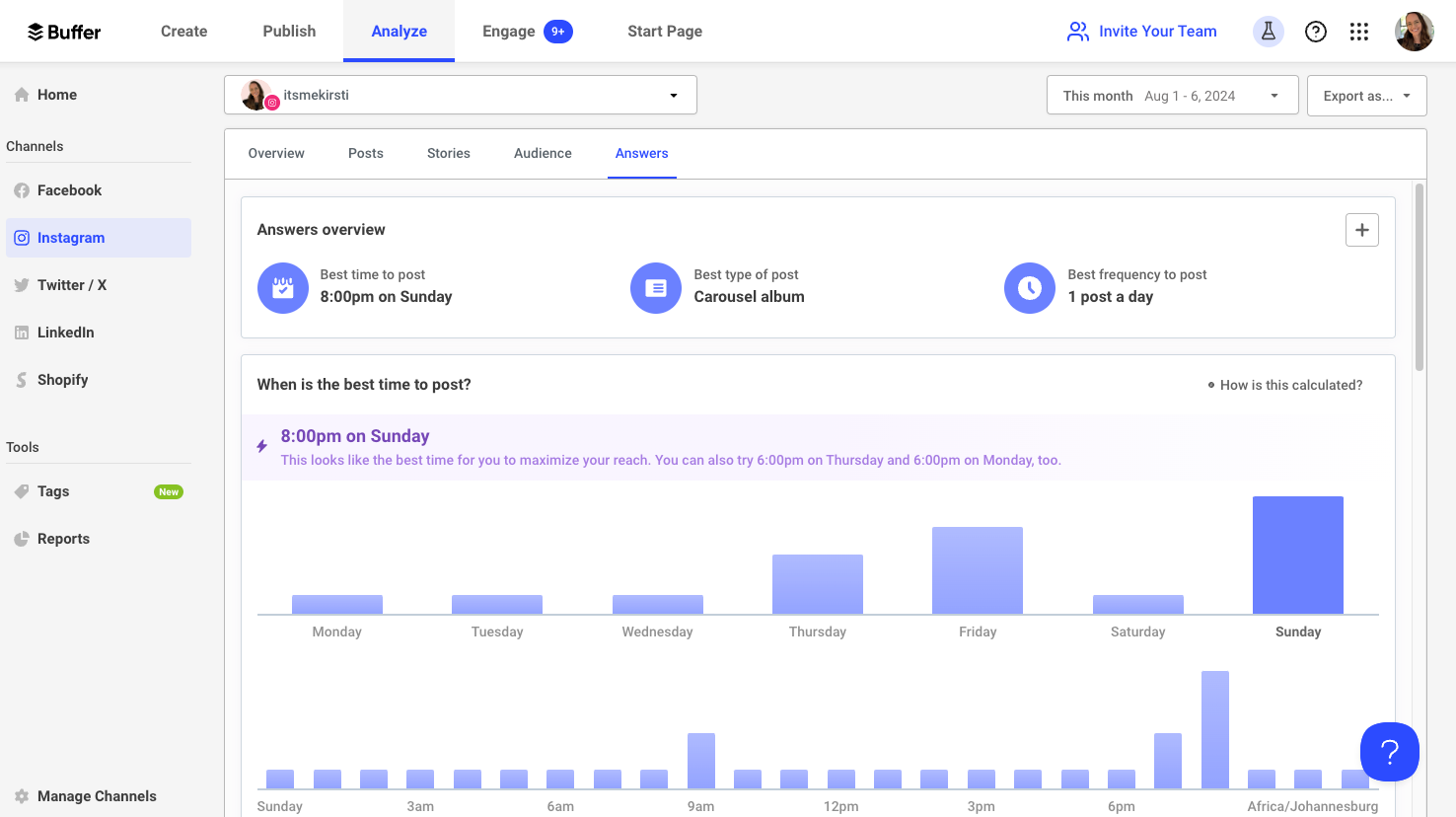
You can create customized reports to share with your boss or partner brands. Click the '+' button next to any section you'd like to include and add it to an existing report or create a new one.
When you're ready, head over to the Reports tab and add a logo and any notes you may want, then export a PDF file you can easily share.
Later’s analytics features
Later’s analytics give you a deep dive into your performance on Instagram Business and Creator profiles, Facebook Pages, TikTok, Threads, and Pinterest accounts.
What you see depends on the platform, but you’ll usually get a channel overview, audience insights, and how your individual posts are doing.
Later gives you some really useful specifics, too. For Instagram, Facebook, TikTok, and Threads, Later breaks down your audience demographics for you — gender, location, and age. And if you're active on Instagram or TikTok, it will even pinpoint when your followers are online and most likely to engage with your content.
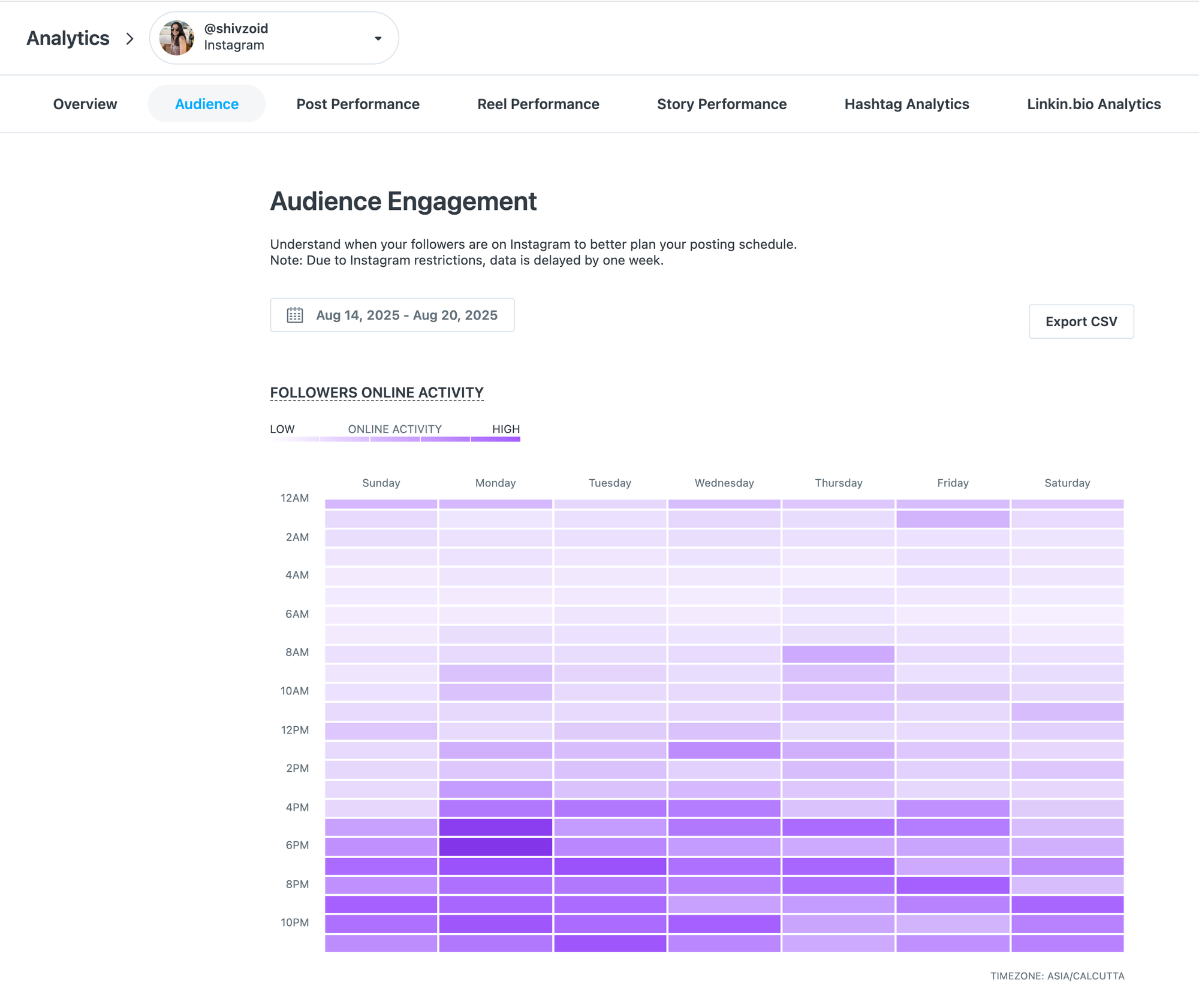
It’s a little trickier if you’d like to see analytics from multiple social media accounts in one view — the feature is available, but only on the highest-tier plan.
Reporting has some restrictions too. While there’s no option to create and export PDFs directly, you can easily download the data as a CSV file.
For Instagram users, there’s also a neat option to generate a shareable performance report link for the past 90 days. It’s an in-depth analysis of your Instagram performance with metrics for profile growth and audience demographics, as well as post and story data.
Link in bio tools
Buffer and Later both offer link-in-bio tools to share in your social media profile bios.
There are some similar features across the two: you can add links to your social profiles, buttons with links, and an email signup form to build an email.
There are also a few differences in how they work.
Buffer Start Page: There are plenty of ways you can use Buffer’s link-in-bio tool, known as Start Page:
- Share links to websites or pages you'd like to highlight
- Embed YouTube videos and Spotify tracks, playlists, or podcasts
- Add a custom image grid (with links)
- Schedule unique posts specifically for this page
Each of these content types works as a block, and you can add multiple blocks of the same type.
What does this mean? If you'd like to create two image grids — one to show off your latest products, and another to highlight brand collabs — there's no stopping you!
Later Link in Bio: Here's how you can use Later's link-in-bio tool:
- Embed featured media, such as a YouTube video, your latest TikTok or Instagram post, or a custom image
- Add a featured banner to promote your most important link
- Add an image banner with multiple linked items
- Embed posts from your Instagram or TikTok profile with custom links
The image banner works as a carousel allowing you to display multiple images.
For every other content type, you can only use one at a time. So if you'd like to highlight a YouTube video, you won't be able to add a custom graphic as well.
A really handy add-on to Later’s link-in-bio tool is its integration with affiliate marketing platform Mavely. For supported brands, you can convert your links into affiliate links right within the tool to earn a commission.
You can absolutely add affiliate links to and earn a commission from your Start Page as well. You’ll just have to copy the link from your affiliate network and paste it into the block.
Team collaboration features
For social media managers, agencies juggling multiple clients, or creators working alongside a consultant, team collaboration tools can make a big difference in how smoothly things run.
Buffer and Later both have robust collaboration features that make it easy to work with a team to bring your social media strategy to life.
Managing teams in Buffer
You can add an unlimited number of users to the platform on Buffer's Team plan, and set different access and permissions.
You can give users:
- Full posting access: They can schedule posts to be published without another team member's approval.
- Approval required: All their scheduled social media content will need approval from someone with full posting access before it is published.
You can also restrict which accounts they have access to so they can schedule or post to only specific social media accounts. It’s a straightforward scheduling process with just two user roles.
Managing teams in Later
Later uses Access Groups to manage who can see and work with social profiles, media libraries, and calendars. It can be incredibly useful for teams and agencies working across multiple brands or clients.
That said, it can also be a bit inflexible. Each Access Group is tied to a full social set, and you can only add one profile from each social media network to a social set.
This means, for example, you can’t place two profiles from the same platform (like a LinkedIn profile and a LinkedIn Page) or multiple Facebook Pages in the same social set.
To make both available, you'd have to assign them to separate social sets, and then assign both social sets to the same Access Group — which then locks other groups out of those accounts.
To get around this, you’d need to purchase another social set for social media accounts on other networks.
You can add multiple users to an Access Group, and you can add users to multiple Access Groups. Like Buffer, you can set roles and permissions for scheduling:
- Reviewer: They can schedule and publish posts without another user's approval, and they can approve other users' posts.
- Member: They can schedule and publish, but they can't approve posts.
- Member (Restricted): All their scheduled content will need approval from someone with Reviewer permissions.
Since Later offers visual content planning, it has a useful shared media library for each Access Group. Users in the group can upload media to the library, and then set labels, make notes, or create alt text. This media can then be dragged and dropped into the calendar to easily schedule.
There’s no equivalent in Buffer, but you could use images saved in the Create Space as the starting point for a post.
Influencer marketing features
In addition to its social media management tools, Later also has a separate product built for influencer marketing. Brands and agencies can use it to run campaigns, find and manage influencer relationships, and measure results.
There are a few extras too, like a Shopify integration that makes it easy to send products to influencers, or the option to get creative support from Later’s team.
It’s separate from the social media management platform, and pricing isn’t listed upfront.
Creators using Later’s social media scheduling tools get access to a Creator hub. You can put together a media kit, apply to campaigns, and manage collaborations — all included in your existing plan.
Buffer doesn’t offer influencer marketing tools. Its focus is on helping small businesses, creators, brands, and solopreneurs grow their social presence organically. Publishing, engagement, and analytics are built right into Buffer's platform, which makes it easy to stay on track and focus on growing your audience.
Which tool is right for you?
Buffer and Later both have plenty of features to help you with your social media management, so which one is right for you really depends on your needs.
They aren’t identical tools, and the main differences show up in pricing, flexibility, and the features included on each plan.
Buffer focuses on helping small businesses, creators, and solopreneurs grow steadily on social. The free plan offers flexibility and accessibility, and the paid plans add advanced features and analytics.
Later has some great social listening and influencer marketing tools to help with connecting audience conversations to the creators who can amplify them.
If you’re on the fence (or you’ve decided to give Buffer a go!) and have questions, our team is always happy to help. You can reach out to us at hello@buffer.com, and someone from our global team will be on hand to answer your questions!
Sign up today to use our free plan or to test Buffer’s paid plans for free!
Try Buffer for free
190,000+ creators, small businesses, and marketers use Buffer to grow their audiences every month.




